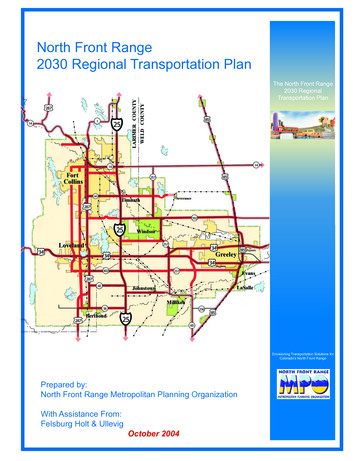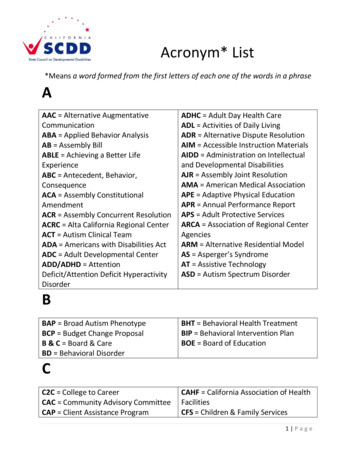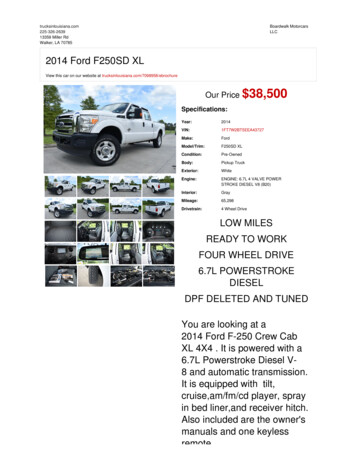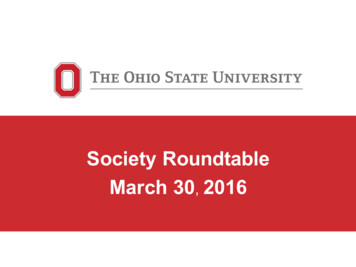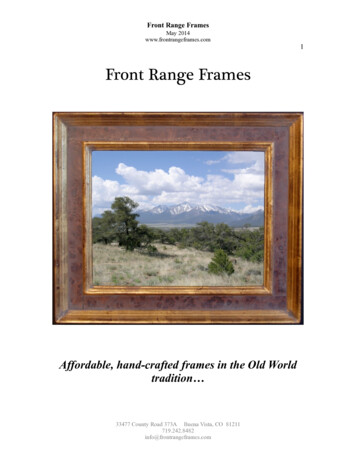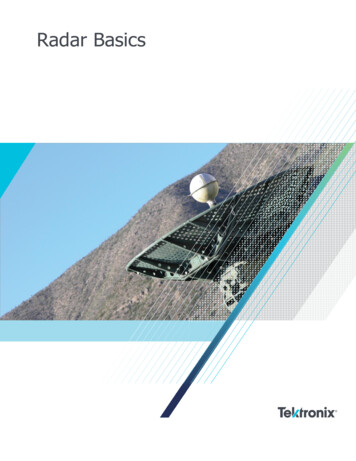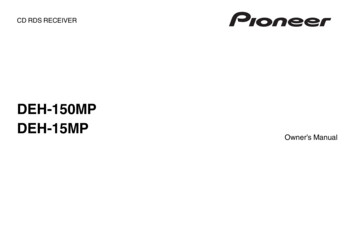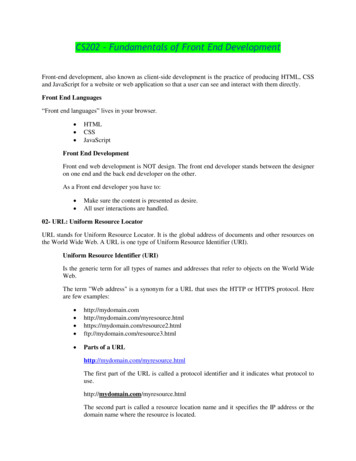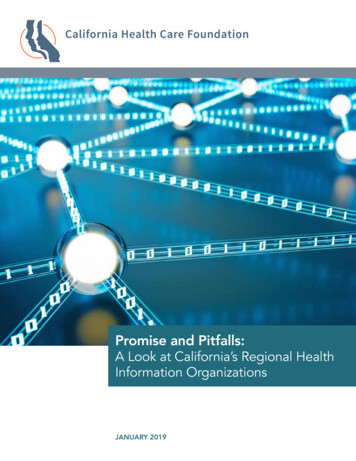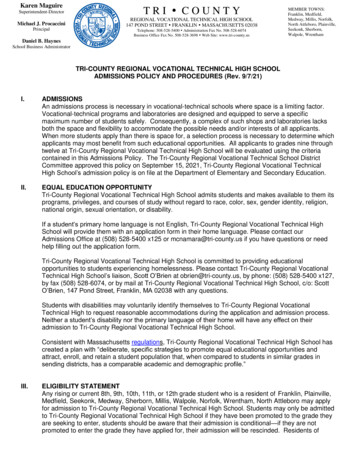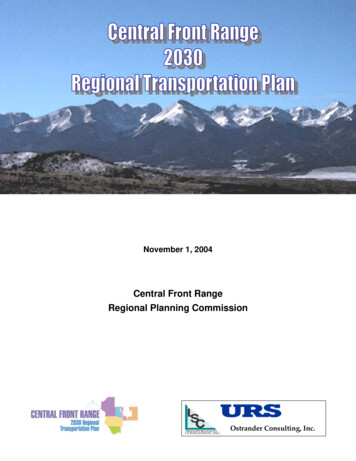
Transcription
November 1, 2004Central Front RangeRegional Planning CommissionOstrander Consulting, Inc.
Central Front Range 2030 Regional Transportation PlanTABLE OF CONTENTSTable of Contents.iList of Exhibits.iList of Appendixes.iResolution of Adoption.iI - Central Front Range Transportation Planning Region . 1Introduction .1The Regional Planning Commission .5Transit Advisory Committee .6Bicycle/Pedestrian Advisory Committee .7II - Public Participation . 8DOLA Outreach Program .8Open House #1.9Open House #2.12Open House #3.14III - Regional Vision, Goals & Strategies . 15Background .15Issue Identification .152030 Vision for Transportation .162030 Goals and Strategies .17IV - Transportation System Inventory . 21Highway System .21Existing Transit Services.40Aviation System .44Rail System .46Bicycle/Pedestrian System .49Intelligent Transportation System .52Intermodal Facilities.52Transportation Demand Management .52V - Socioeconomic & Environmental Profile . 53Population .53Employment .56Environmental Justice .60Major Activity Centers.63Natural Environment .65
Central Front Range 2030 Regional Transportation PlanAgriculture .67Farmland by County.67Historic/Cultural Resources .67Mineral Resources.71Air Quality .71Potential Conservation Areas .73Hazardous Waste Sites .75Water Quality .77Summary Potential Environmental Concerns by Corridor.78VI - Mobility Demand Analysis. 79Mobility Demand Process .79Highway .79Freight .83Public Transportation .86VII - Corridor Visions - Alternatives Analysis. 89Corridor Vision Process .89Corridor Visions.94VIII - Preferred Transportation Plan. 137Multimodal Preferred Plan .137Transit .140Aviation Preferred Project Plan.140IX - Prioritization Process. 143Corridor Prioritization Criteria.143X - Fiscally Constrained Plan . 147Multimodal Constrained Plan.147Transit .148Aviation.149Assessment of Impacts of Plan Implementation.149
Central Front Range 2030 Regional Transportation PlanLIST OF EXHIBITSMap 1 - Study Area. 2Figure 1 - Transportation Planning Process. 3Figure 2 - Regional Planning Commission . 5Figure 3 - Transit Advisory Committee. 6Figure 4 - DOLA Outreach Meetings . 9Map 2 - Base Map. 22Map 3 - National Highway System. 23Map 4 - Scenic Byways Functional Classification . 25Map 5 - Functional Classification. 27Table 1 - State Highway Functional Classification . 28Table 2 - Local Road Functional Classification. 28Map 6 - AADT 2001. 29Map 7 - Volume to Capacity Ratio 2001 . 30Figure 5 – Highway Surface Condition . 31Table 3 - Highway Surface Condition . 31Map 8 - Highway Surface Condition . 32Map 9 - Functionally Obsolete / Structurally Deficient Bridge. 34Map 10 - Accident Locations. 35Map 11 - Commercial Truck Average Annual Daily Traffic 2001. 36Map 12 - Commercial Trucks Percent Total AADT 2001. 37Map 13 - Freight Flows to, From, and Within Colorado by Truck: 1998 (tons. 38Map 14 - Hazardous Materials Routes. 39Table 4 - Transportation Provider Summary . 43Table 5 - Airport Operations. 44Map 15 – Airports. 45Table 6 – Railroad Crossing Accident Prediction Rate . 46Map 16 - Rail Lines in Central Front Range TPR . 46Map 17 - Freight Flows To, From, and Within Colorado by Rail: 1998 (tons). 48Map 18 - Inter-regional Trails. 50Map 19 - Paved Shoulders . 51Table 7 - Population Estimates and Forecasts by County. 54Figure 6 - Population Estimates and Forecasts . 54Table 8- Household Characteristics . 55
Central Front Range 2030 Regional Transportation PlanTMap 20 - Projected Population Change 2000-2030T . 55TTable 9 - Labor Force and Employment. 56Table 10 - Employment by Economic Sector . 57Figure 7 - Employment by Economic Sector. 57Table 11 - Place of Work by County, 1990 - 2000 . 58Table 12 - Means of Transport to Work . 59Table 13 - Transit Dependency by County, 2000 . 61Figure 8 - Percent Population Below Poverty Level, 1999. 62Figure 9 - Minority Status. 63Table 14 - Farmland by County . 67Table 15 - Major Crops. 67Table 16 - Historic and Cultural Resources . 68Table 17 - Mineral Resources . 71Map 21 - Natural Resources . 74Map 22 - Hazardous Waste Sites . 76Table 18 - Potential Environmental Concerns by Corridor . 78Map 23 - AADT 2030. 80Table 19 - Volume to Capacity Ratio 2001-2030 . 81Figure 10 - Volume to Capacity Ratio 2001-2030. 81Map 24 - Volume to Capacity Ratio 2001-2030. 82Map 25 - Estimated Average Annual Daily Truck Traffic: 1998 . 83Map 26 - Estimated Average Annual Daily Truck Traffic: 2020 . 84Table 20 - Freight Shipments To, From, and Within Colorado: 1998, 2010, and 2020 . 85Table 21 - Top Five Commodities Shipped to, From, and Within Colorado by All Modes: 1998/2020. 86Table 22 – Estimated Public Transit Demand . 87Table 23 - TNBS Updated Transit Need Estimates . 87Figure 11 - Ridership Trends . 88Map 27 - Primary Investment Category. 93Table 24 - Preferred Plan . 138Map 28 - Preferred Plan Priorities . 139Table 25 - Aviation Preferred Plan . 142Table 26 - Prioritized Plan . 145Table 27 - 2030 Fiscally Constrained Plan . 148Table 28 - Transit Funding Sources. 149Table 29 - Aviation Constrained Plan. 149
Central Front Range 2030 Regional Transportation PlanLIST OF APPENDIXES(published separately)Appendix A.RPC AgendasAppendix B.Meeting NotesAppendix C.Flyers & AnnouncementsAppendix D.Public Open House ParticipantsAppendix E.DOLA ReportAppendix F.Bridges (table)Appendix G.Rail Crossing Index (table)Appendix H.Representative Projects
Central Front Range 2030 Regional Transportation PlanRESOLUTION OF ADOPTIONCENTRAL FRONT RANGE REGIONAL PLANNING COMMISISONWHEREAS,the State of Colorado has established procedures in Title 43-1-1103 C.R.S. for thecompletion of regional transportation plans as a component of the statewidetransportation planning process; and,WHEREAS,the Central Front Range Transportation Planning Region has been establishedpursuant to rules promulgated by the Transportation Commission Colorado at 2 CCR604-2; and,WHEREAS,the Central Front Range Regional Planning Commission has been established pursuantto Title 30-28-105 C.R.S. as the planning commission with authority to complete theregional transportation plan; and,WHEREAS,the Central Front Range Regional 2030 Transportation Plan and Transit Element datedNovember 1, 2004 has been completed under the authority of the Central Front RangeRegional Planning Commission pursuant to the “Regional Transportation PlanningGuidebook” published by the Colorado Department of Transportation and meets allthe requirements therein;THEREFORE,be it resolved that the Central Front Range Regional Planning Commission doeshereby adopt the Central Front Range 2030 Regional Transportation Plan datedNovember 1, 2004 as it’s official plan to guide transportation development untilsuperceded by a subsequent updated or amended plan; and,THEREFORE,be it resolved that the Central Front Range Regional Planning Commission doeshereby submit to the Colorado Department of Transportation said plan.Dale Hoag, ChairmanCentral Front Range Regional Planning CommissionDate
Central Front Range 2030 Regional Transportation PlanChapter I – The Central Front Range Regional Transportation Planning RegionI - CENTRAL FRONT RANGE TRANSPORTATION PLANNING REGIONINTRODUCTIONThe Central Front Range 2030 Regional Transportation Plan has been prepared as part of the ColoradoDepartment of Transportation’s (CDOT) Regional and Statewide Transportation Planning Process. TheCentral Front Range Transportation Planning Region (TPR) is one of 15 TPRs comprising the entire Stateof Colorado. The Central Front Range TPR consists of Custer, Park, and Fremont Counties, as well as therural parts of Teller and El Paso Counties. The parts of Teller and El Paso Counties that include the Cityof Woodland Park and the Colorado Springs metropolitan area form the Pikes Peak MetropolitanPlanning Area, a separate planning region.The plan considers all modes of transportation and has been instrumental in developing not only longrange plans, but dialogue between representatives of the TPR, local officials, the public, and CDOT. Theplan addresses the planning period from 2005 – 2030. Its purpose is to develop an understanding of thelong-term transportation needs of the region and to identify priorities for funding. This has not been asimple task. The needs are diverse and extensive, while available funding is generally understood asinadequate. Therefore, tough choices have necessarily been made regarding the level of improvementsthat might be reasonably expected –and on what facilities.It is the belief of the Central Front Range Regional Planning Commission that this plan best represents theneeds of the TPR within the context of stringent constraints. The plan also takes a new approach for theTPR in that, rather than a simple project-based plan that attempts to identify specific improvements atspecific locations, it develops a corridor-based approach. The plan identifies multimodal corridors thatmay contain a highway, transit providers and service areas, airports, railroads, and bicycle/pedestrianfacilities. The region’s people, goods and services move on these modes move, which are critical to itseconomic well-being and the general quality of life, not only for this region, but also for the state as awhole.The plan is also unique in that two previously distinct planning processes have been brought together forthe first time. Until now, a Regional Transportation Plan formed the basis for (primarily) state highwayfunding, while the separate Transit Development Program (TDP) was used to establish short- and midterm needs for public transportation providers. The current planning process dispenses with the TDP infavor of the new 2030 Transit Element, containing both short- and long-term public transportation needs.The Transit Element process, while focused on public transportation needs, is an integral component ofthe 2030 transportation plan. While published under separate cover, key sections have been summarizedand incorporated in this document. This plan my be downloaded from the Internet ansStudies/.A grant from CDOT made it possible for the RPC to engage a team of consultants to assist with the plan.URS Corporation provided professional services for the regional transportation plan and LSCTransportation Consultants, Inc., with Ostrander Consulting, Inc. provided professional services for theTransit Element.1
Central Front Range 2030 Regional Transportation PlanChapter I – The Central Front Range Regional Transportation Planning RegionMap 1 - Study Area2
Central Front Range 2030 Regional Transportation PlanChapter I – The Central Front Range Regional Transportation Planning RegionThe Transportation Planning ProcessThe regional transportation plan is based on a combination of the TPR’s Vision and Values with CDOT’sstated policies, goals, and investment strategies. The plans incorporate the statewide transportation visionas expressed by CDOT. Together with statewide surface treatment, safety, and the bridge rehabilitationand replacement programs, the entire state’s needs are encompassed within the Statewide TransportationPlan. In other words, the Statewide Transportation Plan is the summation of needs at the regional andstatewide levels.Figure 1 - Transportation Planning ProcessThe Plan consists of the following steps, which form the chapters of the Plan:1. Establishing the Transportation Planning Region and the Regional Planning Commission2. Public Participation Process3. Regional Vision, Goals, and Strategies4. Inventory of the Existing Transportation System5. Socioeconomic and Environmental Profile6. Mobility Demand Analysis7. Alternatives Analysis8. Preferred Transportation Plan9. Prioritization Process10. Financially Constrained Plan3
Central Front Range 2030 Regional Transportation PlanChapter I – The Central Front Range Regional Transportation Planning RegionConsistency with State and Federal RequirementsThis plan has been completed in response to state and federal requirements to adopt a current long-rangetransportation plan. The planning process is based primarily on TEA-21, Title 43 Colorado RevisedStatutes, Colorado’s Statewide and Regional Transportation Planning Process Rules and Regulations,the Regional Planning Guidebook, and the Transit Element Guidelines.Other sources of guidance included the Colorado Statewide Planning Public Involvement Guidelines,Environmental Justice guidance issued by CDOT and the FHWA, CDOT’s Corridor OptimizationGuidelines, the State of Colorado Access Code, Federal guidance on Limited English Proficiency, andother appropriate documents.This plan meets all regulatory and statutory requirements with respect to public involvement and review,subject matter covered, projected timeline, and other items as required.FHWA ParticipationThis document has been prepared using Federal funding from the United States Department ofTransportation. The United States Department of Transportation assumes no responsibility for its contentsor use thereof.4
Central Front Range 2030 Regional Transportation PlanChapter I – The Central Front Range Regional Transportation Planning RegionTHE REGIONAL PLANNING COMMISSIONThe Central Front Range Regional Planning Commission (RPC) was established by memorandum ofagreement to include a representative from each county and each incorporated municipality within theTPR. The RPC has the responsibility to carry out the regional planning process and adopt the plan. TheRPC met regularly throughout 2003 and 2004 to oversee the plan.Figure 2 - Regional Planning CommissionCentral Front RangeRegional Planning CommissionDale Hoag, ChairmanCommissionerCuster CountyLeni WalkerCommissionerPark CountyChuck BrownCommissionerEl Paso CountyBob CampbellCommissionerTeller CountyLarry LashaCommissionerFremont CountyTammy QuinnMayorFairplayDon StuartMayorWestcliffKathy JusticeMayorVictorTom PiltingsrudMayorFlorenceHarry B. JohnsonMayorCañon CityMarie ChisholmTown CouncilAlmaSue HuttonCity ClerkSilver Cliff5
Central Front Range 2030 Regional Transportation PlanChapter I – The Central Front Range Regional Transportation Planning RegionTRANSIT ADVISORY COMMITTEEThe Transit Advisory Committee (TAC) was established to provide technical guidance during thedevelopment of the Transit Element. The TAC also met regularly throughout 2003 and 2004 to overseetransit planning. Members included transit providers, elected officials, technical staff and the generalpublic.Figure 3 - Transit Advisory CommitteeCentral Front RangeTransit Advisory CommitteeJudy LohnesBarb Riley-CunninghamJamie LewisErik TaurusJulie SyzmulaSue HuttonAlan ButlerJennifer StewartMary HowardLori IsenburgerDick TuttleBernard HopperPat FinifConnie KohlLouise DelgadoMarie ChisholmJean MaySusan Larcom VinesJerry LeStrangeSharyl SolisBill McAleeArt GaideLinda PingsDale HoagJim SchauerBruce RedusRene ShepardBobbi GoreVirginia OlivezWendy ChandenSteve RabeBenny JohnsonBob ChristiansenBeverly SuttonJames PriceSteve CliftonDorothy MartinezDon FarrUpper Arkansas Area COGTeller Senior CoalitionCitizenCitizenCity of SalidaTown of SilvercliffTown of SilvercliffTransit UnitFremont County CabNeighbor to Neighbor VolSalida Senior CenterSouth
Central Front Range 2030 Regional Transportation Plan RESOLUTION OF ADOPTION CENTRAL FRONT RANGE REGIONAL PLANNING COMMISISON WHEREAS, the State of Colorado has established procedures in Title 43-1-1103 C.R.S. for the completion of regional transportation plans as a component of the statewide
